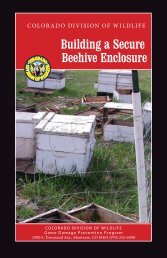Revisiting the Use of Honey for Treating Chronic Wounds
Revisiting the Use of Honey for Treating Chronic Wounds
Revisiting the Use of Honey for Treating Chronic Wounds
Create successful ePaper yourself
Turn your PDF publications into a flip-book with our unique Google optimized e-Paper software.
RCTs and case series to ascertain<br />
<strong>the</strong> effect <strong>of</strong> honey on chronic<br />
wounds such as lower-extremity<br />
ulcers, pressure ulcers, bums, diabetic<br />
ulcers, and slow-healing<br />
wounds in oncology.<br />
Lower-extremity Ulcers—In a<br />
comparative study, Cethin and<br />
Cowman-' used manuka honey to<br />
treat 8 patients with chronic leg<br />
ulcers that had not shown<br />
improvement with o<strong>the</strong>r wound<br />
care <strong>for</strong> 4 weeks. Wound odor was<br />
eliminated after <strong>the</strong> first honey<br />
application, pain duration was<br />
decreased from 2 hours to 30 minutes<br />
(per patient report), and <strong>the</strong><br />
size <strong>of</strong> <strong>the</strong> wound was reduced by<br />
54.8% after 4 weeks <strong>of</strong> <strong>the</strong>rapy.<br />
Smith et al-'" applied Medihoney to<br />
11 chronic lower-extremity venous<br />
ulcers that had failed to respond to<br />
various treatments, including compression,<br />
topical silver, non adherent<br />
dressings, and antibiotic<br />
<strong>the</strong>rapy. All <strong>of</strong> <strong>the</strong> wounds healed<br />
after 3-6 weeks <strong>of</strong> continuous treatment.<br />
Robson et al'5 found that <strong>the</strong><br />
average time to healing was 100<br />
days in <strong>the</strong> Medihoney group versus<br />
140 days in <strong>the</strong> standard-<strong>the</strong>rapy<br />
(control) group <strong>for</strong> lowerextremity<br />
ulcers.<br />
In 3 case studies <strong>of</strong> patients<br />
with leg ulcerations, use <strong>of</strong><br />
Medihoney promoted significant<br />
healing over 2-8 weeks and<br />
reduced pain (per patient report)<br />
and infection (per repeat swab cultures)<br />
in ail cases." In a study <strong>of</strong> 6<br />
patients with non-healing wounds,<br />
use <strong>of</strong> honey produced <strong>the</strong> favorable<br />
outcomes <strong>of</strong> granulation and<br />
reduction <strong>of</strong> bacterial burden over<br />
a mean <strong>of</strong> 4 weeks. ' One patient in<br />
this study who had been experiencing<br />
severe pain was able to stop<br />
using an opioid analgesic after 17<br />
days <strong>of</strong> honey gel treatment and no<br />
longer needed any analgesic after 6<br />
weeks <strong>of</strong> treatment. <strong>Use</strong> <strong>of</strong> honey<br />
achieved <strong>the</strong> goals <strong>of</strong> reducing bacterial<br />
load, inflammation, and<br />
pain. By contrast, in a study conducted<br />
on patients over a 12-week<br />
time period, kill et a!-"' found that<br />
honey with compression, compared<br />
with compression alone, did<br />
not significantly increase healing<br />
<strong>of</strong> venous leg ulcers.<br />
Diabetic Ulcers—<strong>Honey</strong> was<br />
used in an elderly man with chronic<br />
diabetic heel and <strong>for</strong>efoot ulcers<br />
<strong>of</strong> 14 months' duration."' The<br />
patient had lost two toes, had<br />
undergone four surgeries, and had<br />
been hospitalized 5 times in<br />
attempts to heal <strong>the</strong> ulcers.<br />
Cultures <strong>of</strong> <strong>the</strong> wound were positive<br />
<strong>for</strong> MRSA, V'RK, and Pseudomonas,<br />
<strong>Honey</strong> was applied daily;<br />
after 2 weeks, granulation tissue<br />
was noted. The ulcers resolved over<br />
12 months.<br />
Pressure Ulcers—Van der<br />
Weydenw used honey dressings to<br />
treat 2 patients with pressure<br />
ulcers. One patient had a stage 3<br />
ulcer and <strong>the</strong> o<strong>the</strong>r patient had a<br />
stage 4 ulcer; both patients' ulcers<br />
healed after 8-11 weeks <strong>of</strong> treatment.<br />
The patient with <strong>the</strong> stage 4<br />
sacral wound had been treated <strong>for</strong><br />
4 weeks with a hydrocolloid dressing,<br />
with little effect. However,<br />
after 1 week <strong>of</strong> honey treatment,<br />
<strong>the</strong> necrotic tissue began to break<br />
down and after 3 weeks, <strong>the</strong><br />
necrotic tissue was gone. Granulation<br />
tissue was noted after 4<br />
weeks. The o<strong>the</strong>r patient had been<br />
treated with a hydrocolloid dressing<br />
<strong>for</strong> 3 weeks, with no improvement.<br />
One week after starting <strong>the</strong><br />
honey dressing, improvement was<br />
noted, and after 23 days, <strong>the</strong><br />
wound was shallow and granulating.<br />
Acton" used honey to debride<br />
pressure ulcers, with favorable<br />
results. In one case in which a<br />
necrotic pressure ulcer had been<br />
present <strong>for</strong> ) month, <strong>the</strong> necrotic<br />
tissue was absent after 5 days <strong>of</strong><br />
treatment. In ano<strong>the</strong>r case, a<br />
necrotic hip wound was clean after<br />
8 weeks <strong>of</strong> honey use. A 5-week<br />
RCT assessed <strong>the</strong> use <strong>of</strong> honey in<br />
15 patients with 25 stage 2-3 pressure<br />
ulcers versus ethoxy-diaminoacridine/nitr<strong>of</strong>urazone<br />
in 11<br />
patients with 25 stage 2-3 pressure<br />
ulcers.0 The honey-treated group,<br />
relative to <strong>the</strong> control group, experienced<br />
approximately 4 times <strong>the</strong><br />
rate <strong>of</strong> pressure ulcer healing.<br />
Burns—Subrahmanyam et al<br />
treated 100 patients with burns<br />
with a honey dressing or a silver<br />
sulfadiazine dressing. At 7 and 14<br />
days, greater healing was noted earlier<br />
in <strong>the</strong> honey group than in <strong>the</strong><br />
silver sulfadiazine group. The silver<br />
sulfadiazine group showed persistent<br />
infection on bacterial cultures,<br />
whereas cultures in <strong>the</strong> honey<br />
group were 90% sterile. These<br />
authors reported that 50 patients<br />
with bums treated with early exci<br />
sion and skin grafting instead <strong>of</strong><br />
honey had better functional and<br />
cosmetic results after 3 months.<br />
<strong>Wounds</strong> in Patients with<br />
Cancer—<strong>Honey</strong> has been used to<br />
treat slow-healing wounds in<br />
patients with cancer, particularly in<br />
neonate and pediatric populations.<br />
In a study by Simon et al,,: honey<br />
was found effective against nosocomial<br />
wound infections. These<br />
investigators studied wound cultures<br />
growing MRSA, VR1-, and P<br />
aeruginosa from 14 patients whose<br />
slow wound healing was related to<br />
chemo<strong>the</strong>rapy and radiation toxicity,<br />
malnutrition from nausea/<br />
vomiting, mucositis, or infection.<br />
Healing was noted after an average<br />
use <strong>of</strong> 22 days in all wounds.<br />
Patients and <strong>the</strong>ir parents were<br />
pleased with <strong>the</strong> results.<br />
Implications <strong>for</strong> NP Practice<br />
Assessment—The TIME frame-





